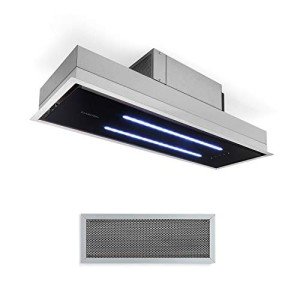Why Adding Island Vent Hood To Your Life's Activities Will Make All The Difference

How to Aerate an Island Vent Hood
Suspended from the ceiling, an island vent hood helps circulate air and keeps your kitchen without smoke and odors. It's also an elegant function that improves your cooking area.
Ventilation types include external venting, which pushes air through ductwork to the beyond your home, and recirculating designs that filter and recycle cooking fumes. Some hoods can even be transformed between one and the other.
Ventilation
Unlike wall-mounted range hoods that vent air vertically through the wall to the outdoors, island vent hoods use ductwork that goes through the ceiling to tire the cooking area to the outdoors. The distinction is that they can also be utilized to recirculate air.
Discover our choice of industrial and designer customized hoods with powerful ventilation systems. With customizable requirements, find the ideal hood for your kitchen area.
Dacor's ConnectOn auto-responsive technology turns on the hood and ramps up the fan speed in action to the cooktop, supplying powerful efficiency while using minimal noise. It's simply another method that you can prepare with self-confidence. Add a touch of contemporary with this stainless steel pyramid-style wall-mount canopy hood. This hood with dignity accentuates advanced kitchen areas that follow a more conventional design style and clarifies of smoke, steam and cooking odors.
Style
Unlike wall-mounted range hoods that are mounted versus the wall, island vent hoods are suspended from the ceiling over an island or peninsula cooktop or range. They likewise use ductwork to tire air out of the home. This design is best for kitchen areas that have a great deal of open space, and it assists to add visual interest to your room. This brand-new home features Blackberry stained cherry kitchen cabinetry on the criterion, and a natural stacked stone on the island and vent hood to complement the Gunstock stain on the cabinets. 10ft ceilings and a skylight assistance to keep the kitchen bright and spacious.
Noise
While an island vent hood does a wonderful task of filtering smoke, grease and smells out of your kitchen, it can likewise create some sound that disrupts the tranquility of your cooking space. Fortunately, there are some methods you can use to minimize this noise and enable you to prepare in peace.
Among the primary causes of excess range hood sound is triggered by fan motor problems such as stiff bearings or badly lubed fans that produce a loud humming sound. Ductwork can likewise contribute to this issue particularly if the ducts are too little or if they are obstructed with dust.
The very best way to reduce noise is to guarantee that your vent hood has the greatest airflow score that you can pay for. The Home Ventilating Institute (HVI) suggests an air flow rate of 100 to 250 cfm for wall-mounted hoods over 30-inch wide ranges. This hood should also have a multispeed fan to enable lower fan speeds during light cooking. Among the easiest ways to lower the noise is to make sure that the ducting is smooth-walled, as corrugated duct limits air flow. You ought to likewise keep the duct runs as brief and straight as possible to prevent any kinking.

Setup
Ventilation of island range hoods is a various procedure than wall-mounted units, since they are suspended from the ceiling over an island or peninsula cooktop or range. They generally require a duct that goes through the ceiling and out through the roof, which can be a complicated job for an unexperienced house owner.
In addition, they need to be set up at least 24-inches to 36-inches above the cooking surface area. The height might differ, depending upon the size of the hood and the ceiling. If you have existing ducting and electrical circuitry in the kitchen ceiling, this type of vent hood is relatively simple to install. If not, it's recommended that you speak with an expert.
To begin this guy , ensure the hood can fit through the opening you have chosen for the vent which it's the ideal width to accommodate the ductwork and exhaust. If the hood is too broad, it can diminish the effectiveness of the vent and will increase sound levels. Next, cut a little hole in the ceiling and utilize a wire cutter to check that there's no pipes or electrical circuitry near the hole. If there is, consider hiring a professional for the job or changing to a recirculating unit.
If there isn't, you can begin the larger vent hole by drilling locator holes with a drill and a 1/2-inch masonry bit in each corner of the location. Then utilize a jigsaw to cut the bigger vent hole. Finally, add a drywall spot and paint to end up the job. Once the hood remains in place, you can run the electrical wiring and connect it to your breaker box. Follow your manufacturer's directions for total setup details.
